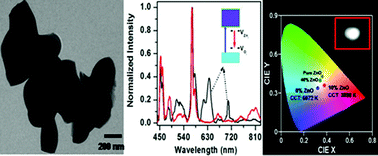Probing a new approach for warm white light generation in lanthanide doped nanophosphors†
Abstract
Lanthanides are among the most acceptable activator ions for cool white light emission; however, solid state lighting for some applications requires a warm white light. Herein, the present work probes a new approach for color temperature tuning in such systems to get a warm white light. The idea is that the additional use of red spectral components in cool white light, to a certain extent, may lead to a perfect warm white light, which can be achieved by making use of the surface oxygen defects mediated red emission from ZnO. To realize this noble concept, white light was initially produced in Y1.993Dy0.001Tm0.006O3 and then further ZnO was added. The study includes detailed structural and optical (steady state and time domain) characterization, chromaticity coordinates (CIE) calculation and correlated color temperature (CCT) analysis. The results show that, initially, at low ZnO concentration, Zn2+ ions prefer to go into the interstitial sites, due to the mismatch of ionic radius between Y3+ (0.90 Å) and Zn2+ (0.75 Å). However, beyond a 10 mol% concentration of ZnO, the solubility limit of Zn2+ ions in the Y2O3 matrix is reached, which results in the development of a Y2O3–ZnO composite. The presence of the ZnO phase gives rise to defect level induced red emission, which tunes the color temperature from 6072 K to 3898 K, which is reasonably good warm white light for solid state lighting applications. This idea can also be generalized in other similar hosts for developing potential warm white light sources.


 Please wait while we load your content...
Please wait while we load your content...